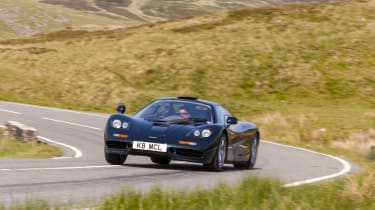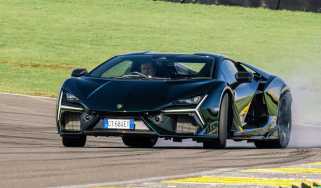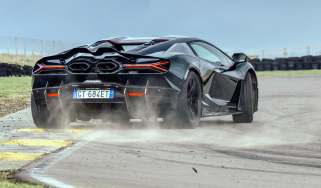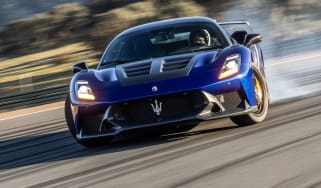The original McLaren F1 press release in full - Every detail of the incredible V12 supercar - History of McLaren
As McLaren re-publishes the full, original 1992 press release for its F1 supercar, it's a perfect time to celebrate the F1, we think
THE MARQUE WAS FOUNDED BY BRUCE McLAREN IN 1964 AND HAS SINCE PRODUCED THE MOST SUCCESSFUL GRAND PRIX CARS IN MOTOR RACING HISTORY
While the McLaren F1 is the british marque’s first production road car, it already boasts a rich heritage…
The McLaren marque was founded by driver/engineer Bruce McLaren in 1964 and in recent years McLaren International has produced the most successful Grand Prix cars in motor racing history.
McLaren drivers Emerson Fittipaldi, James Hunt, Niki Lauda, Alain Prost and Ayrton Senna have all won the Formula 1 World Championship, including seven of the last eight series from 1984, while the marque has also accumulated seven Formula 1 Constructors’ titles.
While McLaren is familiarity associated today with Formula 1, it has also achieved enormous success in sports car competition – particularly in the North American ‘Can-Am’ series, in which the McLaren works cars of Bruce himself and team-mates Denny Hulme and Peter Revson won five consecutive Championship titles from 1967-1971.
Tragically, Bruce died in a Can-Am car testing accident at Goodwood in 1970, and with him went his contemporary dream of the ultimate Grand Touring car – the McLaren-Chevrolet M6GT.
However, the foundations he had laid ensured not only his company’s survival, but also its progress to set new motor racing standards, which it continues to do today…
Bruce McLaren grew up in Auckland, New Zealand, greatly influenced by his garage proprietor father who raced both motor-cycles and cars. Bruce’s first ‘real’ racing car was a 1929 ‘Ulster’ Austin Seven, which he and ‘Pop’ McLaren carefully prepared for local hill-climb competitions.
Bruce won his class first time out and graduated via various Cooper racing cars to become in 1957-58 his country’s first ‘Driver to Europe’. He rapidly graduated to a Formula 1 Cooper works drive in 1959, teamed with their future double-World Champion Jack Brabham.
He became the youngest-ever Grand Prix race winner, and subsequently founded ‘Bruce McLaren Motor Racing Ltd’ in partnership with Teddy Mayer and Tyler Alexander to build Tasman Championship-winning ‘Coopers’ in 1964. Their first sports-racing cars for what became Can-Am racing quickly followed.
McLaren enjoyed immense success, most notably their unique consecutive quintet of Can-Am Championship titles. The marque also established itself in Formula 1 in 1966-67 and won its first Grand Prix races in 1968. Its M16 cars later won three Indianapolis 500-Miles speedway classics in the 1970s.
McLaren’s first World Championship was won by Emerson Fittipaldi in 1974, followed in 1976 by James Hunt’s success. Hard times followed, but decline was arrested in 1980 by a merger between Team McLaren and the highly successful Project Four organisation headed by present McLaren International Managing Director Ron Dennis.
Project Four developed the world’s first moulded carbon-composite racing car which emerged in 1981 as the McLaren P4/1. Driven by John Watson it scored the new McLaren International team’s maiden victory in the British Grand Prix.
In 1983, in conjunction with TAG Group S.A., McLaren International commissioned Porsche to design and develop the TAG Turbo V6 Formula 1 engine. In 1984, it powered new MP4/2s for Niki Lauda and Alain Prost to 12 wins to secure the Constructors’ title, with Lauda taking the Drivers’ crown.
Prost emphasised the team’s domination of Formula 1 by winning back-to-back Championship titles in 1985-86.
Designer Gordon Murray joined TAG/McLaren as Technical Director in 1987 and, in Formula 1 partnership with Honda for 1988, drivers Prost and Ayrton Senna won an unprecedented 15 of the 16 Championship rounds. Ten more GP wins followed in 1989 with Prost taking a third Championship title, while in 1990-91 Senna achieved McLaren’s second consecutive Drivers’ Championship success.
In 1989, the TAG/McLaren Group’s Directors decided to broaden its business base and also to deploy the Group’s vast experience and specialist facilities to exploit Formula 1 technology in a standard-setting road car. Gordon Murray was also seeking a fresh technical challenge and had dreamt for years of creating ‘the ultimate road car’.
Enter the McLaren F1…







